The Evolution of Minecraft
From a Simple Game to a Global Phenomenon
The Humble Beginnings
Markus “Notch” Persson first started developing Minecraft in 2009 as a personal project inspired by games like Dwarf Fortress. He aimed to create a simple block-building sandbox game where players could use their creativity and imagination. The early versions of the game allowed players to break and place different cube-shaped blocks to construct things in a three-dimensional environment. While the gameplay was rudimentary, it provided the foundation for the game’s signature creative and survival gameplay styles.

Expanding the Gameplay Possibilities
As development continued, Markus expanded upon the core block-building mechanics. He added different types of blocks like wood, stone, and fossils that could be found through mining in the world. Tools were introduced to help with construction and combat. The day-night cycle was overhauled to add survival elements, with hostile mobs spawned at night that players had to defend against. Multiplayer was also implemented, allowing groups of players to explore vibrant user-generated virtual worlds together online. These expansions presented new ways for players to interact within Minecraft beyond just building.
Growing to Unprecedented Popularity
After several public alpha and beta stages, Minecraft was officially launched in 2011. Word of mouth from devoted early fans led to unprecedented growth. Within a year, it had sold over 20 million copies across PC, mobile, consoles, and other platforms. both individuals and major tech companies recognized Minecraft’s educational and creative potential. Schools incorporated it for hands-on learning across subjects. Artists, designers, and others leveraged its tools for digital creation. Communities also sprang up to share everything from massive construction projects to personalized mini-game maps and adventure worlds. Minecraft’s rich content ecosystem kept expanding its appeal worldwide.
A Global Phenomenon and Beyond
By the mid-2010s, Minecraft had become a true global phenomenon played by over 100 million monthly users. Beyond gaming, it found applications in fields like urban planning, architecture, and more. Microsoft’s 2014 acquisition of Minecraft’s publisher Mojang for $2.5 billion reflected the game’s mainstream influence and staying power. Under Microsoft, the game continued innovating with major updates like player-made skins, custom world generation, and the Better Together update unifying platforms. In 2022, over 238 million copies had been sold. Though Persson stepped back, Minecraft lives on as one of the best-selling and most influential open-world sandbox games ever made. Its simple beginnings evolved into a cultural touchstone inspiring creativity for all ages.
A Development Story of Humble Beginnings
When Markus Persson began work on what would become Minecraft in 2009, his goal was simply to develop a fun game he enjoyed making. It started as a basic “Cave Game” where players could dig and explore. The early versions focused solely on building, crafting and surviving within procedurally generated worlds. During nights, rudimentary hostile mobs like spiders would spawn. Through persistence and a growing community of dedicated alpha testers, Persson continued expanding the gameplay mechanics with biomes, tools, warfare, and more. By incorporating popular elements from inspirational games like Dwarf Fortress, his project organically evolved into the rich sandbox survival game we know today.
From Indie Passion Project to Global Phenomenon
With each new alpha and beta release, Minecraft grew its devoted playerbase. By 2011, it was ready for its full commercial launch. Its simple yet deeply engaging gameplay with limitless possibilities for creativity and adventure had found an audience of millions. While many doubted its potential at first given the graphics, players were drawn to Minecraft’s carefree spirit and multiplayer communities. It attracted players of all ages, becoming a true shared experience. In just a few years it had sold over 100 million copies, taught in classrooms, and spawned a creative economy. Its success was unprecedented for an indie game, making Minecraft an overnight sensation and proving games need not have realistic graphics to enthrall. It inspired others to pursue their gaming dreams with indie enthusiasm.
A Legacy of Inspiring Creativity for All Ages
More than a decade after its initial development, Minecraft continues evolving while inspiring imaginations worldwide. From the earliest creative players constructing awesome builds to complex redstone circuits, it empowered individuals to design and share whatever they imagined. Communities sprang up across platforms, cultivating a culture of learning through creativity, collaboration and exploration together. Artists, architects, engineers, and students have all leveraged its tools. It transcended gaming to become a platform for self-expression, problem-solving and learning across subjects. With sales now surpassing 250 million, Minecraft’s positive impact through inclusive play remains unprecedented. Though graphics are simple, its gifts of creative joy and community endure for all ages, cementing Minecraft’s legacy for generations to come.
